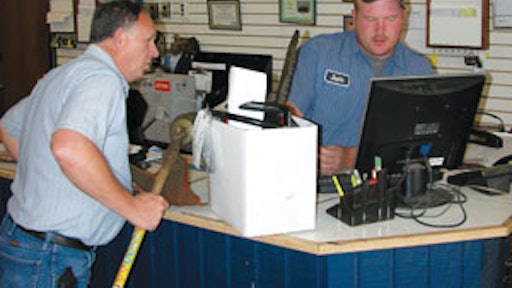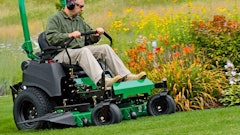
As many dealers have grown and adapted to today’s marketplace, so have business management systems. The tools are there, and it is up to dealers to embrace these features and use them to the best of their abilities with proper BMS training.
THE TECH-SMART DEALER
The dealers of today have come a long way from 10 or 20 years ago. They are finding new and better ways to manage their businesses, using technology more and more. “Pretty much every dealer you talk to now has a computer,” explains Jeff Haefner of Ideal Computer Systems. “Ten years ago they may not have had a computer at work or even at home. Dealers are now using computers and the Internet more than ever. They are using email, checking orders online, looking up pricing and using eBay almost daily.”
In addition to the Internet, more dealers are using a BMS. For years dealers have used some type of software to help them manage their businesses. More now are turning to a BMS designed specifically for outdoor power equipment dealers.
“The more aggressive dealers have embraced the BMS technology and seen value in it,” says Jim Archut of c-Systems Software. “I don’t know how many times I’ve had dealers tell me the single smartest decision they ever made was to purchase a BMS. These are dealers who are aggressively and progressively running their businesses.”
For some of these aggressive dealers, paying careful attention to each department in their business and its profitability may help them to grow into a multi-location dealership. If they do, the BMS will be there to help them along the way.
SYSTEM FEATURES FOR TODAY'S DEALER
As dealers have made several advances in their businesses, so has the BMS in its features. Several business management systems have accounted for dealer growth by developing features to help them manage multiple locations. “A BMS allows for multi-location management of inventories and departments,” says Archut. “These are tools that each location manager needs to keep the two locations tied together.”
In reporting on the dealership’s sales and inventories, the data can be joined together or broken down into several reports. “Combined and separate reporting is a great feature,” shares Haefner. “Today reporting is more flexible, whereas 10 years ago dealers would only have standard reports to choose from. Now dealers can easily slice and dice information almost however they want.” This data, which is at the same time simple to extract and complex in reporting, allows for thorough multi-location management.
In addition to multiple-location management tools, several BMS features have been introduced that incorporate technological advancements made in the last decade. A few of the newer features in some of the outdoor power equipment business management systems available include:
Digital signature capture pad – The digital signature capture allows dealers to capture customer signatures for purchases, equipment pickups and charging to an account. “Dealers save ink, paper and time,” says Haefner.
Technician time clock – The technician time clock tracks how long a tech works on a repair from start to finish. It allows dealers to keep a close eye on individual technician efficiency. Dealers can also ensure they are billing the appropriate amount of hours.
Email and text messaging – Dealers and their employees can email and text message customers directly from the BMS. “It’s great for alerting customers about new products, the status on repairs, warranty information and more,” says Archut.
Partners Standard Protocol (PSP) – Covering several industries, the PSP is an agreed upon protocol for communication between the dealer, distributor and OEM. It simplifies the processes for purchase orders, warranty registrations and more. Several OEMs are on board, as well as BMS providers such as Ideal Computer Systems and c-Systems Software. For more information on the PSP, visit psp.mic.org.
These and all of the other features in a BMS are designed to help dealers stay on top of their businesses and in touch with their customers, with the end goal being profitability. Knowing how to use your system properly will get you closer to that end goal.
REALLY USING YOUR BMS
A BMS is a great tool, but only if you know how to use it. “You just don’t see dealers who have the time, knowledge or expertise to figure out all the features on their own,” says Haefner. “Having all of the accurate information right in front of you lets you know the status of things, better manage technicians, improve customer service and more. If we can teach dealers to use these tools they are going to be more profitable.”
Some dealers figure out the basic bookkeeping and are satisfied enough with that, but don’t try to get all that they can out of the system.
“There is a level of complacency for some dealers,” explains Archut. “They are doing well at what they are doing, but they could be doing even better. It can be difficult to convince them to take the lead and change how they are using the BMS.”
If a dealer does decide they want more from their system, the help is out there. Many BMS companies provide extensive training and tools to their dealers. “Every month we provide users with an update on any enhancements that have been made as well as a quarterly newsletter,” says Archut. “On top of that, our salesmen call customers once or twice a year to see how things are going.” c-Systems offers phone support as part of their normal maintenance agreement, and additional training, either at their headquarters, the customer’s site or over the Internet. Ideal also provides a customer service hotline and ongoing training.
While several new features have been introduced, dealers should be certain they have a grasp on the basics like tracking and comparing costs with revenue. “When it comes down to it, the core fundamentals that have been around for years are still the same things that are going to make dealers a lot of money,” explains Haefner. “Knowing those things and having a reliable BMS you can count on is what is going to make you a better, more profitable business—or even help you stay in business.”
Many of today’s dealers have come a long way thanks to careful business planning and management. Using a BMS to its full abilities—including new features and those that have been around for years—could help take you to the next level.
Seven Easy Ways to Increase Profitability with Your BMS
1. Track technician efficiency
2. Use as a tool for answering customer inquiries
3. Set goals for sales margins
4. Track and reduce dead inventory
5. Track and analyze top-selling products
6. Create a system for customer follow-ups
7. Scrutinize lost sales reports






























